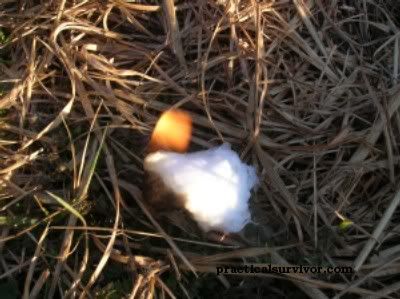
Click title or picture for full article.
Several companies make magnesium blocks as fire starters. Coghlan's, Doan Machinery, Gelert Flint Lighter, and Liberty Mountain to name a few. We tested the Doan Machinery block. The magnesium blocks consist of two parts.
1. The magnesium which we scrape for tinder.
2. A small flint rod glued to the side of the block. (Ferrocerium rod)
* The rod will create a hot spark when scraped against a sharp edge.


We took the magnesium block into the woods after a day of rain.
Ambient temperature: 35 degrees Fahrenheit

Another useful hint, is to use a dry leaf to contain the shaving as you are trying to spark. Be careful not to scrape too hard and hit the leaf. A piece of duct tape can be used to keep the wind from blowing the shavings away. Place pieces of tinder around the shavings.


There are several techniques we use to scrape the flint rod on the block.
One method we hold the knife stationary against the ground and pull the block carefully across the edge of the blade.


Another method is to scrape the blade down the flint rod. Note: Try not to hack at the rod. Not only is this dangerous but it will damage the flint rod.
We scrape the blade down the rod side to get a spark. As we mentioned before, some knives will allow the use the back edge of the knife (the spine) in order to protect the blade edge. (some people file down the knife spine to add groves or expose the metal). For demonstration purposes we used the edge of the knife hoping to create a larger spark on film.

The metal blade from the Swedish Firesteel will create a hot spark.

In a real survival situation do whatever it takes to get the spark, but remember that you should protect your knife edge if possible.



Later we tested the magnesium and it did not start a fire quite like we would like. As a matter of fact, twice we were able to ignite the tinder before the magnesium. However, we will be doing more testing on the magnesium. It is likely I was not making a large enough pile of magnesium. There are a few methods I want to try when it comes to creating the spark.
Different methods
Alternate way to scrape the magnesium and the flint rod
Hold the blade to the ground (on the tinder). Place the magnesium block on the knife edge. With a pulling motion, scrape the magnesium on the blade. Slowly create a nice pile of magnesium shavings. Sometimes I will place a dry leaf within the tinder to catch the shavings.


Now reverse the magnesium block to the flint rod side. We then pull the rod across the knife edge in a smooth motion. This will create a spark. If we create the shaving and spark without moving the knife, it should easily ignite the tinder.


Using a small pocket knife




Using Centerfinger's survival tool





During more testing:
After a full day of rain, I took the time to create a nice pile of magnesium from the block. We took the time to search for fairly dry tinder. We find that fallen trees usually make a good place to find and make tinder. This will be covered in the starting fire in the rain article.
Please read our Fire in the Rain article for advice on adverse weather fire starting.

Click title or picture for full article.
.
The magnesium block continues to prove itself as a reliable fire starter even in damp conditions.
Swedish Firesteel metal tab
Here we ignite the grass on the ground after a light rain. With practice, anyone should be able to start a fire with this tool.




Things to keep in mind. People always ask why hikers do not carry a lighter. Naphtha (Zippo) lighters require lighter fluid and they dry out as time passes. Butane lighters can stop working too. We have seen them leak and the flint corrode and freeze. The option is to carry a naphtha lighter with a bottle of fluid. This could be useful if you need to start a fire in the rain. But takes more space in your pack. Fire starters such as a flint rod or magnesium block are small and lightweight. Overall we prefer the idea of a tool unaffected by water or corrosion.

practicalsurvivor.com is licensed under a Creative Commons Attribution-Noncommercial-No Derivative Works 3.0 Unported License.



